Why is it uncomfortable to urinate?
Why does a urethra get constricted?
I have difficulty emptying my bladder, what could this mean?
Urethral Strictures Causes
A urethral stricture is a narrowing of the urethra, leading to difficulty urinating, along with other signs and symptoms. There are a number of different ways this condition can develop, and below are a few of the most common urethral stricture causes.
Straddle Injury
A straddle trauma injury is a common way to injure the urethra and possibly cause a urethral stricture. A straddle injury is when there is a trauma injury between the thighs, oftentimes caused by straddling a hard object such as a bike crossbar or fence. While many patients do not develop symptoms until months or years after an injury, some may immediately see bleeding and an inability to urinate after the injury. Straddle injury strictures are typically in the bulbar urethra, although we often have patients diagnosed with bulbar strictures who are unable to recall any inciting trauma or incident. However, in the absence of other prior urologic procedures, it is very unusual for a man to develop a bulbar stricture in the absence of trauma. Therefore, it is likely some forgotten trauma in the past caused the injury and subsequent stricture.
Pelvic Bone Fracture Posterior Urethral Disruptions
A pelvic bone fracture is a very serious injury that can have long-lasting consequences. Common causes of pelvic fractures include automobile and motorcycle motor vehicle accidents, as well as injuries in which the pelvis is crushed, usually in a work-related environment. When the pelvis is fractured, in some cases the bone is not the only part of the body that is impacted. There is also sometimes an associated tear of the membranous portion of the posterior urethra. This urethral tear usually results in the ends separating, leading to the patient completely losing the ability to urinate.
Lichen Sclerosus (LS) = Balanitis Xerotica Oblitarans (BXO)
Lichen Sclerosus (LS), also known as Balanitis Xerotica Obliterans or BXO, is an often debilitating disease of which the cause is still unclear. The primary symptom of LS is a whitish discoloration of the penile skin, and as a result of the disease, individuals can often develop urethral strictures. Strictures caused by LS can oftentimes involve the meatus (urethral opening at the tip of the penis) alone, but in other cases can also result in longer strictures.
Hypospadias Surgery
Hypospadias is a condition in which a boy is born with incomplete development of the urethra. Instead of the opening of the urethra occurring on the tip of the penis, those with the condition have their urethra on the underside of the penis. Treatment for hypospadias is often surgery, with the surgery aiming to add tissue to the urethra and bring the urethra opening to the tip of the penis. Hypospadias surgery can be complicated by urethral stricture development. This is more fully discussed in the Hypospadias section.
Urologic Procedures
Oftentimes in the treatment of urologic or other diseases, it is necessary to advance catheters or instruments through the urethra and into the bladder. In these kinds of treatments, the instrumentation can cause damage to the urethra and eventually lead to the formation of a stricture. The portion of the urethra close to the urethral opening at the tip of the penis (the fossa navicularis), is the area most often affected by urological procedures. In addition, prostate surgery or radiation can be associated with very complex strictures involving the bladder neck and/or membranous urethra.
Other Causes
The above represents some of the most common causes of strictures. However, there are some more rare urethral stricture causes, including inserting foreign objects into the urethra and urologic surgeries such as penile implant surgery. While certain large medical information websites often mention urinary tract infections such as gonorrhea as causes of strictures and suggest the cause is often infectious, this only occurs in very extreme circumstances. While infections such as gonorrhea may be related to stricture formation, this is at best a very rare cause.
The most common urethral stricture symptoms are a significantly lower urine flow rate and an increase in the amount of time needed to empty the bladder. One way to think about how a urethral stricture can lead to these symptoms is by comparing it to as garden hose. A kink or stepping on a garden hose leads to a low flow of water out the end, even if the affected area is just one small segment of a long hose.
When Do Symptoms Present Themselves?
Urethral stricture symptoms can develop very gradually over time or present themselves almost immediately. In some cases, patients are so accustomed to the slow flow rate of their urine that they are not even aware that there is a problem. However, when asked these patients can usually recall that when standing next to others at a urinal, the sound and duration of their urination was different than that of the people surrounding them.
Urethral Stricture Symptoms Lead to More Serious Problems
If the only problem associated with stricture disease were a slow urine flow rate, most patients would likely choose not to pursue treatment and just “live with” the condition. Unfortunately, the obstruction to urine flow caused by urethral strictures can lead to many more serious problems and consequences.
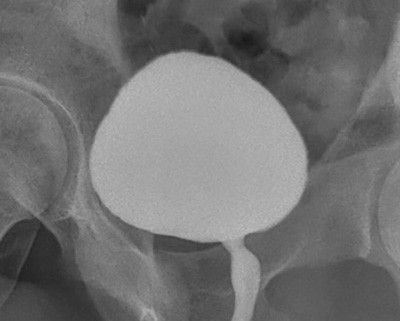
This is a healthy bladder during urination after being filled with contrast material that appears white on an x-ray film. Notice that the contour of the interior of the bladder is smooth.
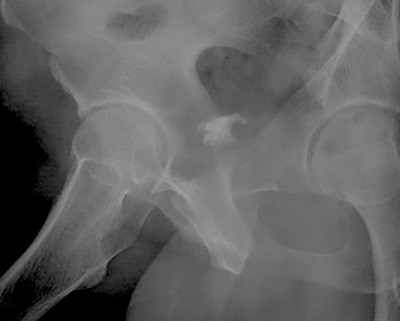
This is an image obtained immediately after urination. Very little contrast remains. The amount of urine that remains in the bladder immediately after urination is called the post-void residual (PVR). It is normal for the PVR to be 0 or close to 0, meaning that there is little to no urine left in the bladder following urination.
A urethral obstruction forces the bladder to squeeze harder to overcome the resistance the stricture causes. This continual strain causes the bladder to gradually thickens, resulting in damage to the bladder. The interior of the bladder is no longer smooth, and images of the inside of the bladder reveal an abnormal strand-like appearance. Imaging also reveals significant irregularity of the bladder wall, which is called trabeculation.
When there is urethral obstruction, the bladder has to squeeze harder to overcome the resistance. Eventually, the bladder thickens. This represents damage to the bladder. The interior of the bladder is no longer smooth. Visualization of the inside of the bladder reveals an abnormal strand like appearance, and imaging reveals significant irregularity of the bladder wall. This is called trabeculation.
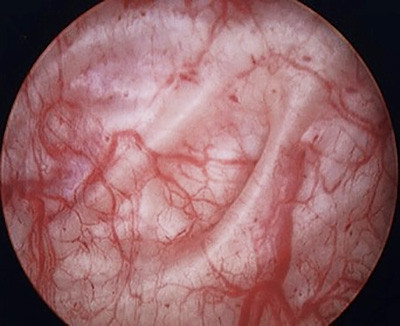
Trabeculation within the bladder
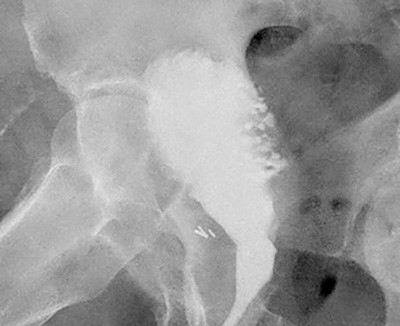
Bladder imaging showing trabeculation.
In some cases, the damaged bladder can get even worse because of the pressure required to overcome the resistance of urethral obstruction. This pressure can actually cause the inner lining of the bladder to herniate through the muscle of the bladder, leading to one or more outpouchings. These outpouchings, called bladder diverticula, are not surrounded by muscle and therefore may not empty during urination, leading to dangerous infections.
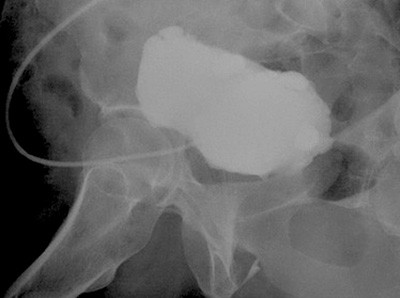
Multiple diverticula
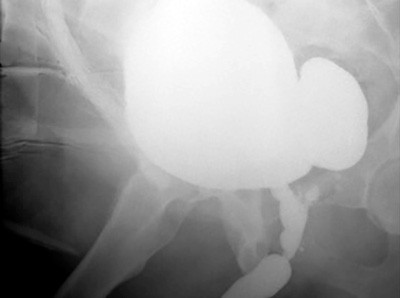
Single very large diverticulum
In addition, urethral strictures can cause the bladder to become enlarged. This enlargement makes the bladder less able to completely empty during urination, leading to abnormally high residual urine volumes. It is not uncommon for patients to have residuals (PVRs) of 100-200cc. Some patients have such extensive bladder damage from prolonged obstruction that the residual urine in the bladder after urinating is twice the amount a normal bladder can hold when full prior to urinating.
This patient (film shown below) with stricture disease had a PVR of over 1000cc
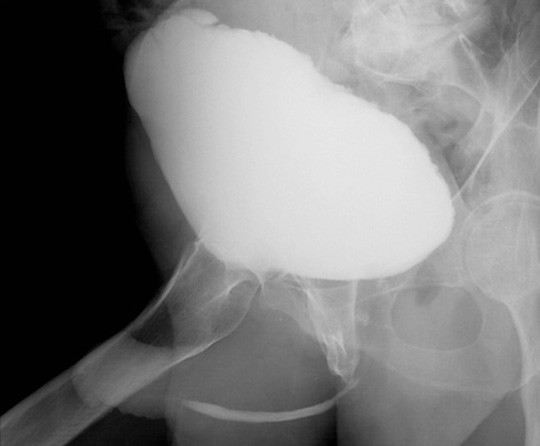
As the bladder becomes progressively damaged, additional symptoms can include the frequent need to urinate during both the day and at night (called nocturia), sudden urges to urinate (urgency), and a sensation of incomplete emptying. Urine infections can also occur, and while urine infections are somewhat common in women, they are fairly rare in men. When a man develops even a single urine infection immediate evaluation is needed to determine the reason, as there is often an underlying cause that needs to be addressed.
The prostate gland and sperm from the testicles enter the urethra during ejaculation, and this is generally a one-way flow towards the urethra. When there is distal blockage of the urethra, the pressure during urination within the bladder and urethra above the blockage can rise. This increased pressure can lead to a flow of urine in the wrong direction, moving towards the prostate and/or epididymis/testicle. When this happens, patients can develop infections of the prostate (called prostatitis), the epididymis (called epididymitis) or the testicle (called orchitis). In rare cases, the backup can be so severe that urine can even travel back from the bladder all the way to the kidneys.
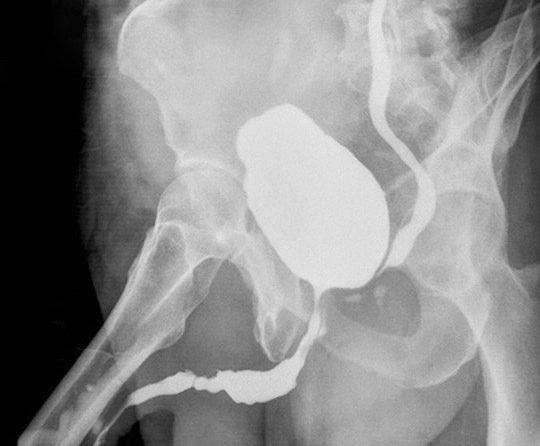
This is called reflux (as shown).
Kidney infections and kidney and/or bladder stones can then occur. In severe cases, the kidneys can be reversibly or irreversibly damaged (renal failure).

